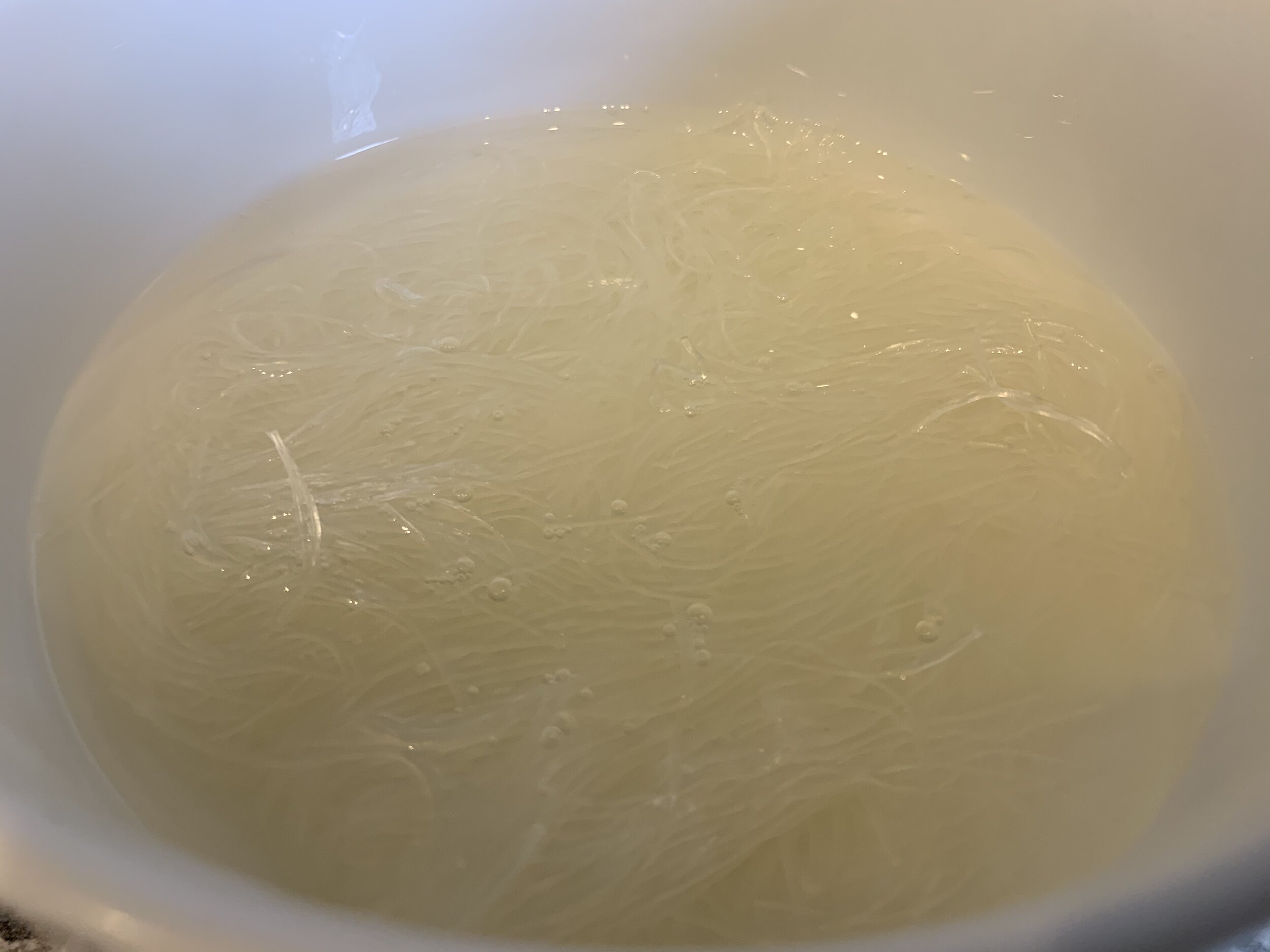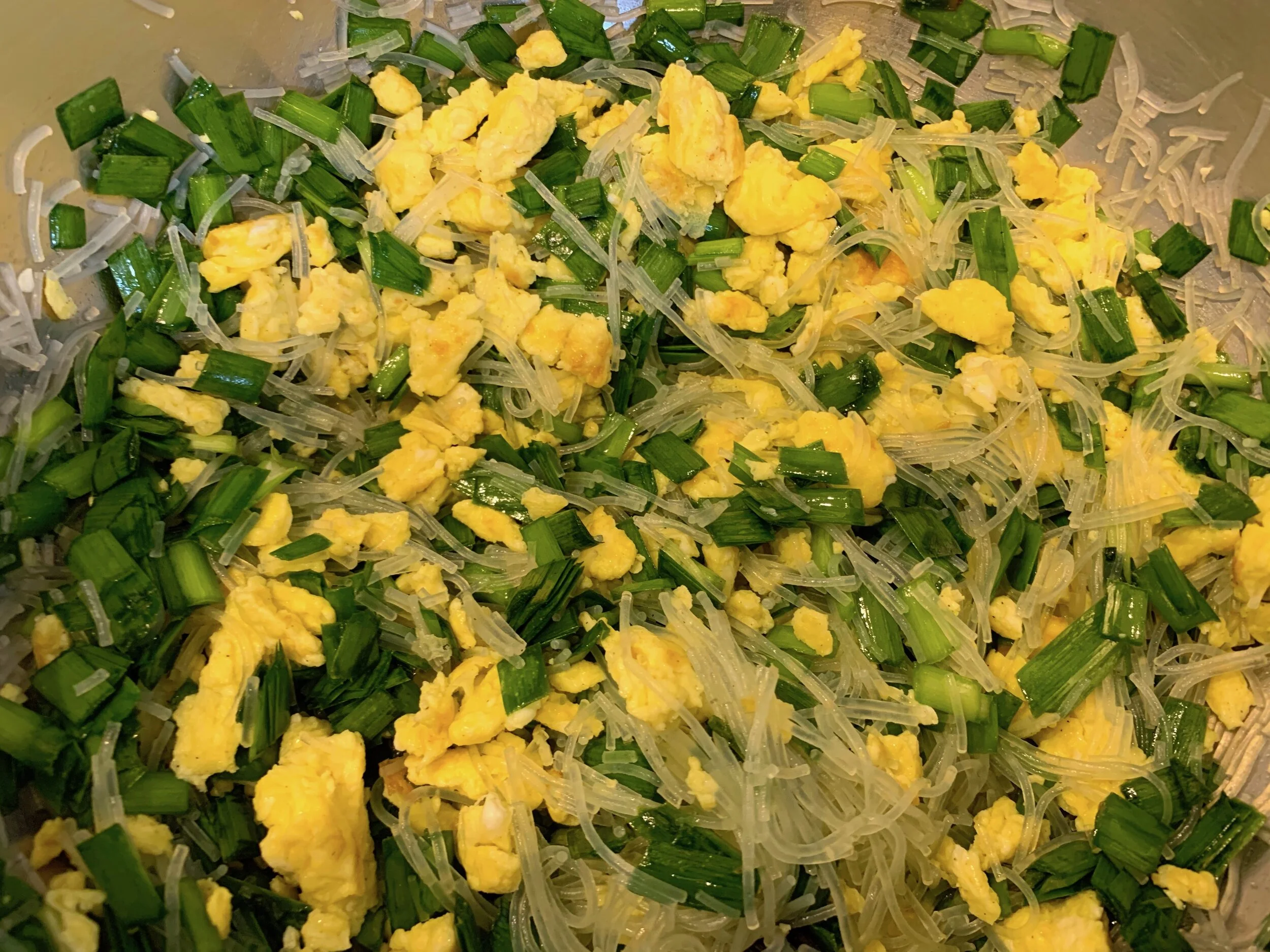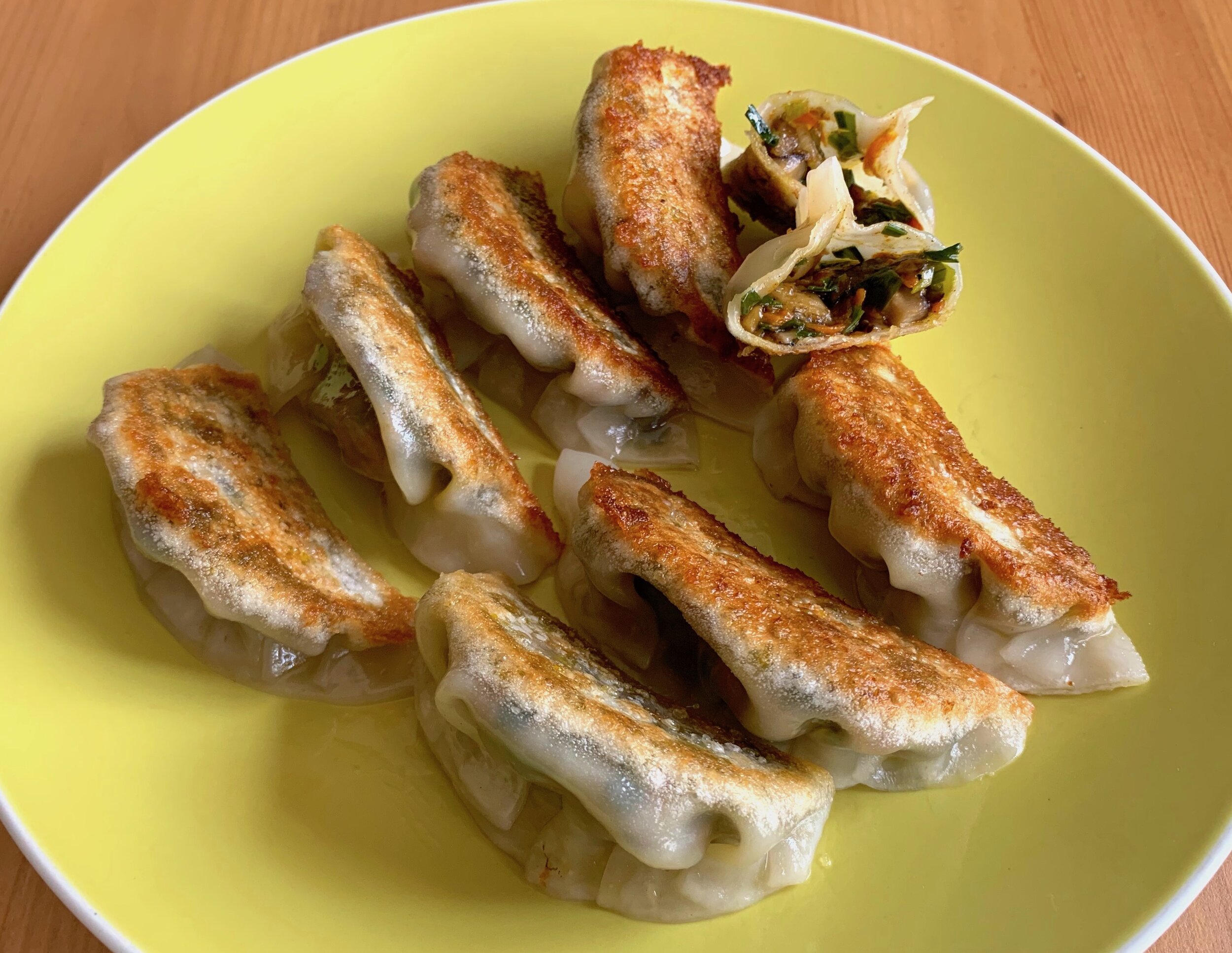Chinese Chive Pockets

Chinese chive pockets (韭菜盒子), also sometime known as chive boxes or chive pies,[1] are a savory pocket pie similar in appearance and construction to other turnovers, such as Cornish pasties or empanadas. These pastries originate in the Shandong province, where both wheat and garlic chives [2] have long been cultivated.
Ingredients
2 cups flour
1 cup water, boiled
5 oz garlic chives
4 eggs
3 oz bean thread vermicelli
1 tsp salt
¼ tsp white pepper
Vegetable oil
The dough for chive pockets is a hot water dough similar to that used for dumpling wrappers. Begin by boiling some water. Why boiling water in this dough? Hot water will denature some of the proteins in the flour and prevent as much gluten from forming, resulting in a more pliable dough.
In a large mixing bowl, place two cups of all-purpose flour. Form a well and pour in 1 cup of boiling water, stirring immediately and vigorously with chopsticks or a wooden spoon. Continue stirring until a dough forms. If the dough feels too dry, add some more water—if it is too moist, add flour. At this stage the dough will likely be slightly sticky and somewhat crumbly. Begin kneading the dough together in the bowl, bringing the crumbs together into a single ball. Continue kneading for about 10 minutes, until it is smooth.
Cover the dough ball with plastic or a clean tea towel, and let rest for 1 hour. As there is no leavening agent in this dough, no rise will occur. However, the dough will relax and become more elastic, which decreases the chance of tearing when we roll out the wrappers.
While the dough rests, we can prepare the filling, which contains three main components—garlic chives, eggs, and vermicelli noodles. Infuriatingly, there is no standard English translation for the noodles we need for this dish. They can be called bean thread vermicelli, mung bean noodles, cellophane noodles, glass noodles, or other combinations of similar words. To make things even more confusing, multiple types of noodles, which unhelpfully all look pretty similar, get labeled with similar words (vermicelli, cellophane noodles, and glass noodles). To find the right noodles in your local Asian supermarket, you are best off looking for the Chinese characters for “fen si” (粉絲) or “dong fen” (冬粉). Another strategy is to look for the ingredients list, which will be printed in English. If you find thin, white noodles made of mung bean starch, you’ve probably got the right ones.
Soak the vermicelli in hot water for 5 minutes. This rehydrates the noodles, and they should become flexible and translucent. Drain the softened noodles, then cut them into ½ inch pieces. I find the best tool for this is a pair of kitchen shears. Chop the garlic chives into ½ inch pieces as well, and place them in a large mixing bowl, together with 1 teaspoon vegetable oil and 1 teaspoon salt. Mix well and set aside. The salt will draw some moisture out of the chives, and the oil will prevent the leaves from sticking together when cooked.
Beat the 4 eggs, and heat about 1 tablespoon of oil in a pan over medium heat. When the oil is hot, pour in the eggs and cook for about 3 minutes, breaking the egg up into small pieces as it sets. Then add the vermicelli noodles to the pan and cook for 2 more minutes, stirring constantly. By pre-cooking the filling, we ensure that when it comes to cooking the chive pockets, we need only worry about cooking the dough, and not the filling. Add the egg and vermicelli to the bowl with the chives. Season with white pepper, mix the filling until it is well combined, and let cool.
When the dough is rested, form it into a log about 1 inch in diameter and divide it into 12 equal pieces. This dough can dry out quickly, especially when it has been divided into small pieces and rolled thin. Once it dries out, it will crack, making it difficult to wrap anything with them. For this reason, it is important to keep all dough pieces which are not being worked on covered—both the unrolled pieces and the finished wrappers.
Dust a work surface with flour, and roll the pieces out one at a time. To form the wrappers, begin by rolling the small piece of dough into a rough ball between your palms, then flattening it into a puck. Place this puck on the work surface, and place your rolling pin at the center. Roll the pin gently towards the edge, then rotate the puck by 30 degrees or so, place the rolling pin back at the center, and repeat the rolling motion towards the edge.
This is easiest with a Chinese or French rolling pin, a small, tapered, wooden rod. The roller-style American pins will not give you sufficient control when rolling. Continue turning the dough and rolling towards the edge until you form a thin circle about 5 inches in diameter, with a thickness of about 1/8th of an inch.
To make a pocket, place about 3-4 tablespoons of filling on one half of the wrapper. Then fold the other side of the wrapper over, forming a large half-moon. Crimp the edges together to seal, being sure to push any air out of the pocket. If you find that the edges of the wrapper have become too dry to crimp together, moisten the edges with some water as you would a dumpling.
You can freeze the chive pockets in the freezer for long-term storage—simply place them on a parchment or plastic wrap-lined plate in a single layer and freeze. Once they are frozen solid, you can transfer them to a plastic bag and keep in the freezer.
If you are cooking the chive pockets immediately, heat 1 tablespoon vegetable oil in a nonstick pan over medium heat. When the oil is hot, add the pockets to the pan in a single layer and fry for 5 minutes per side, or until the dough is cooked through and has become golden brown and crisp.
If you are cooking a pocket from frozen, treat it like a big potsticker: heat some oil in a pan and place the frozen pockets in the pan. Add about ¼ cup water to the pan and cover immediately. The steam will help thaw the pocket and cook the dough. Once all the water has evaporated, uncover the pan and fry the pocket on both sides until golden brown.
Serve the chive pockets warm, with some chili sauce or black rice vinegar for dipping, as desired.
Substitutions
If you can’t find bean thread vermicelli, other thin glass noodles made of potato starch or tapioca starch can be used as substitutes. However, rice vermicelli is not a substitute for bean thread vermicelli—it has a very different texture when cooked. Some variants of this recipe include dried shrimp or bits of ground pork in the chive filling.
[1] In Chinese, 韭菜盒子 translates literally to “chive box.”
[2] Garlic chives (Allium tuberosum) are sometimes referred to as Chinese chives or Chinese leek. They are native to southwest China, and are considered an invasive weed in some other parts of the world.
Recipe
Prep Time: 1 hr Cook Time: 15 min Total Time: 1 hr 45 min
(+30 min inactive)
Difficulty: 3/5
Heat Sources: 1 burner
Equipment: pan
Servings: 12 pockets
Ingredients
2 cups flour
1 cup water, boiled
5 oz garlic chives
4 eggs
3 oz bean thread vermicelli
1 tsp salt
¼ tsp white pepper
Vegetable oil
Instructions
1. Place the flour in a large bowl. Pour the boiling water into the flour, and stir immediately. Continue stirring vigorously until a shaggy dough forms. Adjust the amount of water as necessary.
2. Form the dough into a ball and knead for 10 minutes, until smooth. Then let rest, covered, for 1 hour.
3. While the dough rests, rehydrate the bean thread vermicelli by soaking them for 5 minutes in hot water. Then drain and use kitchen shears to cut the vermicelli into ½ inch pieces.
4. Chop the garlic chives into ½ inch pieces and place them in a mixing bowl. Toss them with 1 tsp vegetable oil and 1 tsp salt.
5. Beat the 4 eggs, and fry the egg in a pan over medium heat for 3 min or until cooked through, breaking the egg into small pieces. Add the cut vermicelli to the pan and stir-fry for 2 min.
6. Remove the egg and vermicelli mixture from the heat and add to the bowl with the chives. Add the white pepper, mix well, and let the filling cool.
7. Shape the rested dough into a log and then cut into 12 equal pieces, dusting them with flour so they do not stick. Cover the pieces with plastic wrap or a clean tea towel.
8. Dust your work surface with flour and roll the pieces out one at a time into rounds of 5 inches in diameter, and a thickness of about 1/8th of an inch.
9. Place 3-4 tbsp of filling onto one side of the wrapper, then fold the other side of the wrapper over. Crimp the edges together to seal, pushing any air out of the pocket. Repeat until all pockets are folded.
10. To cook, heat 1 tbsp vegetable oil in a nonstick pan over medium heat. When the oil is hot, add the pockets to the pan in a single layer and fry for 5 minutes per side, or until the dough is cooked through and crisp.






























